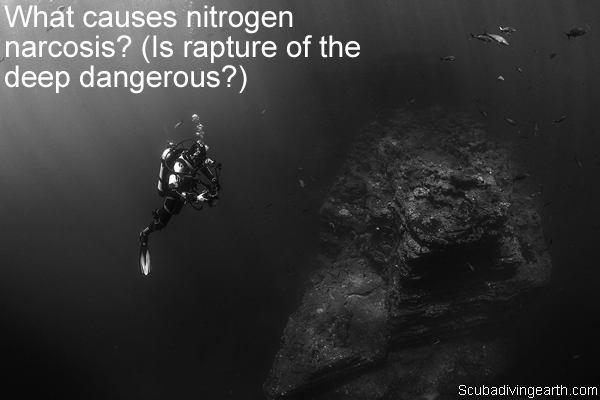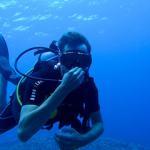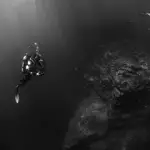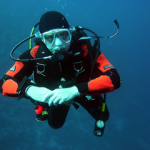
Why does nitrogen narcosis occur?
One of the risks of scuba diving is nitrogen narcosis (also known as the narks, raptures of the deep, the Martini effect or inert gas narcosis). But what causes nitrogen narcosis and why does it occur?
What causes nitrogen narcosis? Scientists are not sure of the exact cause of nitrogen narcosis. But they are aware it’s due to inhaling compressed air at pressure, which increases the pressure of nitrogen in your blood. This has an effect on your central nervous system and the effects are most noticeable at depths below 30 metres (98 feet).
The best way to do more diving but by avoiding nitrogen narcosis, is to book yourself on a scuba diving liveaboard. You can check the latest and best deals on liveaboards using the following window:
What causes nitrogen narcosis?
Nitrogen narcosis (The Narks) or ‘Raptures of the Deep‘ is usually only experienced at dive depths in excess of 30 metres. So if you don’t want to risk experiencing the Narks, keep your dive depths to less than 30 metres.
However, if you want to dive deeper, then you need to understand what nitrogen narcosis is and what causes it.
Scuba diving involves breathing of compressed air from a dive tank. But more importantly, scuba diving involves going underwater. As water is more dense than air, there’s increased pressure on your body when you dive.
The deeper you dive, the greater the pressure. This increase in pressure is demonstrated by the following table.
Dive depth pressure table
| Depth | Pressure | Risk of Narcosis |
|---|---|---|
| Sea level | 1 Bar | None |
| 10 metres (33 feet) | 2 Bar | None |
| 20 metres (66 feet) | 3 Bar | Very Low |
| 30 metres (98 feet) | 4 Bar | Mild |
| 40 metres (131 feet) | 5 Bar | High |
| 50 metres (164 feet) | 6 Bar | Very High |
It’s the increased pressure on your body that affects whether you get narcosis or not. The deeper you dive the chances of narcosis increase. But once you descend below 30 metres, you enter the ‘Narcosis-zone‘ depth.
It’s the breathing of air under the pressure of water that impacts how much of the nitrogen molecules are dissolved into your tissues and blood stream.
78% of air is nitrogen
Bearing in mind that 78% of air is nitrogen. It’s this gas that has a greater impact on you when you’re breathing atmospheric air at depth.
Which is similar to decompression sickness, which is also caused by the nitrogen in the air you breath as a scuba diver. Also, and just like nitrogen narcosis, the deeper you dive, the greater the risk of decompression sickness too.
More Reading: How Deep Can You Dive Without Decompression (No Decompression Stop Limits)
With regards to nitrogen narcosis, it’s this extra dissolved nitrogen that finds its way to your brain, where too much nitrogen can affect the brain. This is because nitrogen is an anaesthetic at increased pressure.
It only takes around three minutes for the narcotic effects to reach a maximum and you only need to go past the 30-metre (98 feet) mark and narcosis can kick in quite quickly.
However, if you experience narcosis in this way, it can be overcome by ascending a metre or so. The narcotic effect usually disappears quite quickly, which will allow you to descend once more.
This happened to me on a number of deeper dives to 30+ metres. I usually found that on the second attempt to descend, I didn’t feel the affects of narcosis.

What’s the impact of nitrogen narcosis on divers?
It the nitrogen that causes the condition nitrogen narcosis or Raptures of the Deep. But what are the symptoms of narcosis?
The following are conditions commonly caused by nitrogen narcosis:
- Reduced manual dexterity and delayed responses.
- A reduction in cognitive and sensory ability, including mental confusion.
- Reasoning is affected and loss of short term memory.
- Impaired judgement and confusion.
- Sleepiness or dizziness.
- Errors in calculations.
- Euphoria and a sense of excessive confidence that can lead to laughter underwater.
- Anxiety or ‘Terrors’ or manic depressive states.
- Coma and death.
With regards to the above symptoms of nitrogen narcosis, the deeper a diver goes, the more likely they are to suffer these effects. But also, the deeper the dive, the more severe the symptoms will be.
Is ‘raptures of the deep’ dangerous?
In the above list of conditions of nitrogen narcosis, I listed death as a possible outcome. This is more likely at depths of 50+ metres (164 feet +). It’s at these deeper depths where the water pressure is greater when the risks get higher.
Having said that, death from raptures of the deep isn’t that common in scuba divers. But it can be dangerous and it’s a risk to be aware of when considering a deep dive.
Incidences can happen as a consequence of nitrogen narcosis, rather than as a result of the narcosis itself. For example, when I got a severe attack of anxiety at a depth of 47 metres, which was brought on by nitrogen narcosis, I could have died as a consequence.
More Reading: Can You Survive 47 Meters Underwater? (47 Metres In Feet = 154 Feet)
I ended up hyperventilating due to the anxiety attack. This could have cause me to run out of air, before reaching the surface. But luckily I survived to tell the tale.
I hope you enjoyed this article about what causes nitrogen narcosis
I’d love to hear from you. Tell us about your adventures of diving and snorkeling, in the comments below. Please also share your photos. Either from your underwater cameras or videos from your waterproof Gopro’s!
If this article hasn’t answered all of your questions. If you have more questions either about snorkeling or scuba diving (or specifically about what causes nitrogen narcosis), please comment below with your questions.
There will also be many more articles about scuba diving (and snorkeling) for you to read and learn about these fabulous sports.
Have fun and be safe!




